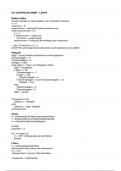Other
oplossingen extra oefeningen programmeren python dawynt dodona H3: Loops
- Course
- Institution
- Book
Oplossingen op extra gemaakte oefeningen van reeks 3 (loops - controlelussen) op dodona voor vak programmeren van peter dawnyt ugent python.
[Show more]



